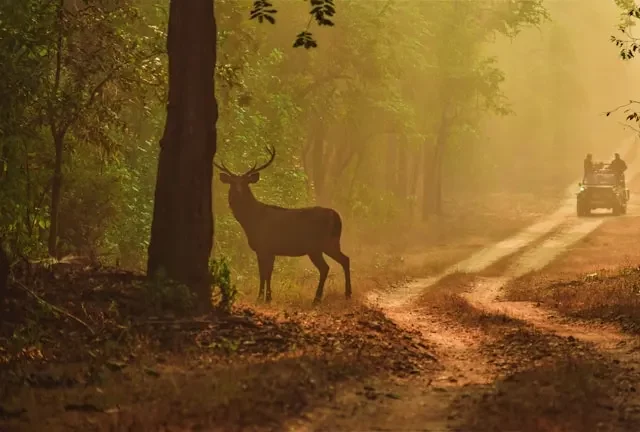Jeep to Jungle: A Practical Guide to Wildlife Photography on Kanha Safari
Nestled in the heart of Madhya Pradesh, Kanha National Park is woven with lush green landscapes and a captivating array of wildlife. Famed as the emerald home of the majestic Bengal tiger, Kanha National Park has charmed enthusiasts for centuries. Even Rudyard Kipling is believed to have drawn inspiration from Kanha’s beauty for his timeless classic, “The Jungle Book.”
Kanha is a photographer’s dream as many call it. With its diverse ecosystems, from sprawling meadows to dense forests, and an abundance of captivating creatures, Kanha National Park promises an unforgettable photographic adventure.
Here’s your guide on what to include in your photography gear for Kanha national park and the best time for photography in Kanha.
Preparing for Your Kanha Safari Photography
A Kanha national park photography expedition depends on proper preparation. Here’s what you need to pack for capturing the park’s magic
Camera Gear Essentials
- Telephoto Lens with a focal length of a minimum 200mm or above to get close-up shots of Kanha wildlife without disturbing them. You may also consider a zoom lens for versatility.
- A lightweight tripod with a smooth-operating head is ideal for kanha jeep safari photography as low-light conditions and capturing sharp images of moving animals require a stable platform.
- Spare batteries are essential, especially for early morning and late afternoon safaris. Make sure you pack enough memory cards to avoid running out of space.
- Dust is a constant companion on Kanha safari so don’t forget to pack a lens cleaning cloth and blower to remove any dust particles.
Mastering Camera Settings for Kanha Safari Photography
- Low Light Prowess: Consider using a fast shutter speed (around 1/500th or higher) to freeze action while adjusting the aperture (wider aperture like f/4 or lower) to let in more light. Be prepared to adjust ISO (light sensitivity) to achieve a balanced exposure, but be mindful of increasing noise at higher ISO levels.
- Capturing Movement: Wildlife rarely stands still. Practice using burst mode to capture multiple frames of an animal in action.

Optimizing Your Kanha Photography Experience
Beyond having the right gear, a successful Kanha national park photography experience is based on understanding the park’s dynamics and employing strategic techniques.
The best time for photography in Kanha is during the Golden light hour as it boats the most captivating light for wildlife photography.
Composition and Focusing Techniques for best wildlife photography in forest
- The Rule of Thirds: Dividing your viewfinder into a 3×3 grid. Place your subject at the intersection points for a more balanced and aesthetically pleasing composition.
- Leading Lines: Use natural elements like tree branches or animal tracks to draw the viewer’s eye toward your subject.
- Negative Space: Use negative space around your subject to create a sense of isolation and emphasize its importance.
- Mastering Focus: Practice using autofocus modes like continuous tracking to keep moving subjects sharp.
Beyond the Tiger: Capturing Kanha’s Diverse Wildlife Tapestry
The park’s biodiversity offers a photographer’s dream beyond the stripes. Here’s how to capture the captivating stories of lesser-known, but equally remarkable, creatures, along with tiger photo in Kanha
Focusing on Birds in Flight: Here’s how to capture birds in flight kanha national park
- Shutter Speed for Sharpness: Birds are fast-moving and thus require shutter speed of 1/1000th or faster for freezing their motion and capturing sharp wing details.
- Tracking Techniques: Practice anticipating bird movements and panning your camera smoothly to follow them in flight. Utilize autofocus modes like continuous tracking to maintain focus.
- Compositional Creativity: Capture birds in action, not just perched. Look for interesting backgrounds, dramatic sunrises/sets illuminating feathers, or unique behaviors like hunting or feeding their young.
Don’t get tunnel vision! While tigers are a highlight, capturing Kanha’s wildlife, from soaring birds to elusive mammals, will create a more compelling and well-rounded photographic story of your Kanha safari adventure.

Post-Processing for Perfection
Transforming Your Kanha Memories into Masterpieces
Your Kanha photography journey continues even after capturing the moment. Post-processing allows you to refine your images, enhance details, and create a visually stunning narrative. Here’s how to turn your raw Kanha photos into polished masterpieces with these editing tips for Kanha wildlife photos.
Basic Adjustments for Enhanced Photos
- Exposure and White Balance: Make use of editing software like Adobe Lightroom or Photoshop to adjust exposure for a balanced image. Correct white balance to ensure accurate color representation which is especially important for capturing the warm tones of sunrises and cool hues of twilight scenes.
- Color Vibrancy and Clarity: Subtly enhance the richness of Kanha’s colors by adjusting vibrancy and clarity. But don’t overdo it so as to preserve the natural beauty of the scene.
Sharpening and Noise Reduction
- Sharpening for Crisp Details: Sharpening the images can bring out the fine details of fur, feathers, and textures. However, be cautious while doing so, as excessive sharpening can create unwanted artifacts.
- Noise Reduction for Low Light Images: Photos taken in low-light conditions might exhibit digital noise. Make use of noise reduction tools to minimize the graininess, but be careful not to over-smooth the image and thus lose the original details.
Post-processing is a powerful tool, you just need to make sure that doesn’t drastically alter the reality of your photos. Only use it to enhance the natural beauty of the captured images.
Conclusion
Your photographs are more than just beautiful captures. They are a documentation of wildlife behavior and contribute to our understanding of these creatures. By showcasing the beauty and diversity of Kanha National Park, your photography can raise awareness about conservation efforts and inspire others to support the protection of this vital ecosystem.
Motivated to capture the magic of Kanha yet? Book a Call with us Today! We’ll discuss your photography goals and craft the perfect Kanha safari itinerary to bring your dream wildlife shots to life.

